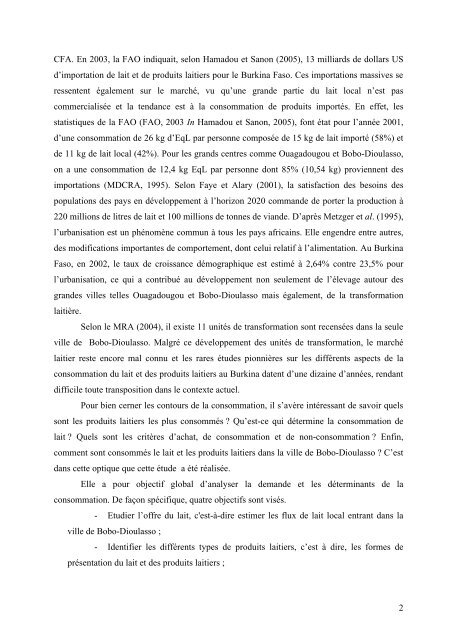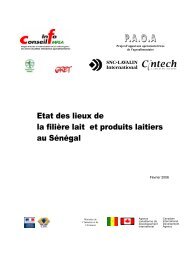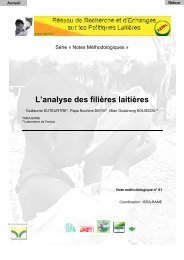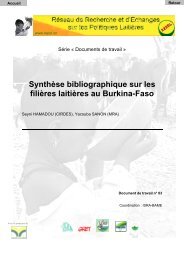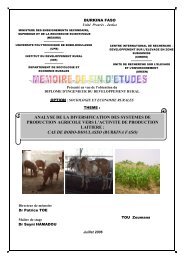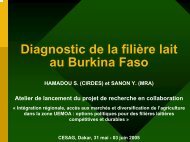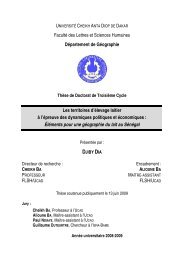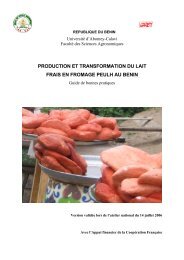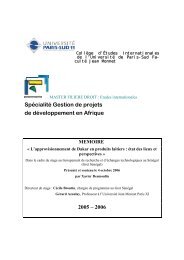Analyse de la consommation du lait et des produits laitiers : - REPOL
Analyse de la consommation du lait et des produits laitiers : - REPOL
Analyse de la consommation du lait et des produits laitiers : - REPOL
- No tags were found...
You also want an ePaper? Increase the reach of your titles
YUMPU automatically turns print PDFs into web optimized ePapers that Google loves.
CFA. En 2003, <strong>la</strong> FAO indiquait, selon Hamadou <strong>et</strong> Sanon (2005), 13 milliards <strong>de</strong> dol<strong>la</strong>rs USd’importation <strong>de</strong> <strong>la</strong>it <strong>et</strong> <strong>de</strong> pro<strong>du</strong>its <strong>la</strong>itiers pour le Burkina Faso. Ces importations massives seressentent également sur le marché, vu qu’une gran<strong>de</strong> partie <strong>du</strong> <strong>la</strong>it local n’est pascommercialisée <strong>et</strong> <strong>la</strong> tendance est à <strong>la</strong> <strong>consommation</strong> <strong>de</strong> pro<strong>du</strong>its importés. En eff<strong>et</strong>, lesstatistiques <strong>de</strong> <strong>la</strong> FAO (FAO, 2003 In Hamadou <strong>et</strong> Sanon, 2005), font état pour l’année 2001,d’une <strong>consommation</strong> <strong>de</strong> 26 kg d’EqL par personne composée <strong>de</strong> 15 kg <strong>de</strong> <strong>la</strong>it importé (58%) <strong>et</strong><strong>de</strong> 11 kg <strong>de</strong> <strong>la</strong>it local (42%). Pour les grands centres comme Ouagadougou <strong>et</strong> Bobo-Diou<strong>la</strong>sso,on a une <strong>consommation</strong> <strong>de</strong> 12,4 kg EqL par personne dont 85% (10,54 kg) proviennent <strong>de</strong>simportations (MDCRA, 1995). Selon Faye <strong>et</strong> A<strong>la</strong>ry (2001), <strong>la</strong> satisfaction <strong>de</strong>s besoins <strong>de</strong>spopu<strong>la</strong>tions <strong>de</strong>s pays en développement à l’horizon 2020 comman<strong>de</strong> <strong>de</strong> porter <strong>la</strong> pro<strong>du</strong>ction à220 millions <strong>de</strong> litres <strong>de</strong> <strong>la</strong>it <strong>et</strong> 100 millions <strong>de</strong> tonnes <strong>de</strong> vian<strong>de</strong>. D’après M<strong>et</strong>zger <strong>et</strong> al. (1995),l’urbanisation est un phénomène commun à tous les pays africains. Elle engendre entre autres,<strong>de</strong>s modifications importantes <strong>de</strong> comportement, dont celui re<strong>la</strong>tif à l’alimentation. Au BurkinaFaso, en 2002, le taux <strong>de</strong> croissance démographique est estimé à 2,64% contre 23,5% pourl’urbanisation, ce qui a contribué au développement non seulement <strong>de</strong> l’élevage autour <strong>de</strong>sgran<strong>de</strong>s villes telles Ouagadougou <strong>et</strong> Bobo-Diou<strong>la</strong>sso mais également, <strong>de</strong> <strong>la</strong> transformation<strong>la</strong>itière.Selon le MRA (2004), il existe 11 unités <strong>de</strong> transformation sont recensées dans <strong>la</strong> seuleville <strong>de</strong> Bobo-Diou<strong>la</strong>sso. Malgré ce développement <strong>de</strong>s unités <strong>de</strong> transformation, le marché<strong>la</strong>itier reste encore mal connu <strong>et</strong> les rares étu<strong>de</strong>s pionnières sur les différents aspects <strong>de</strong> <strong>la</strong><strong>consommation</strong> <strong>du</strong> <strong>la</strong>it <strong>et</strong> <strong>de</strong>s pro<strong>du</strong>its <strong>la</strong>itiers au Burkina datent d’une dizaine d’années, rendantdifficile toute transposition dans le contexte actuel.Pour bien cerner les contours <strong>de</strong> <strong>la</strong> <strong>consommation</strong>, il s’avère intéressant <strong>de</strong> savoir quelssont les pro<strong>du</strong>its <strong>la</strong>itiers les plus consommés ? Qu’est-ce qui détermine <strong>la</strong> <strong>consommation</strong> <strong>de</strong><strong>la</strong>it ? Quels sont les critères d’achat, <strong>de</strong> <strong>consommation</strong> <strong>et</strong> <strong>de</strong> non-<strong>consommation</strong> ? Enfin,comment sont consommés le <strong>la</strong>it <strong>et</strong> les pro<strong>du</strong>its <strong>la</strong>itiers dans <strong>la</strong> ville <strong>de</strong> Bobo-Diou<strong>la</strong>sso ? C’estdans c<strong>et</strong>te optique que c<strong>et</strong>te étu<strong>de</strong> a été réalisée.Elle a pour objectif global d’analyser <strong>la</strong> <strong>de</strong>man<strong>de</strong> <strong>et</strong> les déterminants <strong>de</strong> <strong>la</strong><strong>consommation</strong>. De façon spécifique, quatre objectifs sont visés.- Etudier l’offre <strong>du</strong> <strong>la</strong>it, c'est-à-dire estimer les flux <strong>de</strong> <strong>la</strong>it local entrant dans <strong>la</strong>ville <strong>de</strong> Bobo-Diou<strong>la</strong>sso ;- I<strong>de</strong>ntifier les différents types <strong>de</strong> pro<strong>du</strong>its <strong>la</strong>itiers, c’est à dire, les formes <strong>de</strong>présentation <strong>du</strong> <strong>la</strong>it <strong>et</strong> <strong>de</strong>s pro<strong>du</strong>its <strong>la</strong>itiers ;2


